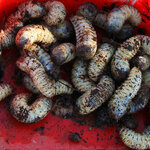Microbiology

Though the claims that acrylamide is dangerous seem to be more manufactured hype than science, that isn't stopping the free market from providing an alternative.
Renaissance BioScience Corp. has received a “no questions” response from the U.S. Food and Drug Administration (FDA) for its acrylamide-reducing baker’s yeast strain. The concern about acrylamide, a universal by-product of foods containing asparagine (which is a lot of them - many carbohydrate-rich foods have this natural amino acid), is because the International Agency for Research on Cancer, classified it as a Group 2A carcinogen (…

You might think microbreweries are novel and trendy. Okay, they may be trendy but they are not novel. An ancient microbrewery dating around 5,000 years old was recently unearthed in China at the archaeological site of Mijiaya.
Analyzing the remnants of the grains used has even provided a recipe for ancient Chinese beer!
Alcoholic drinks have a long and complicated history. Indeed, long before humans even came on the scene, other animals were indulging in fruit that had naturally fermented.
Trees that bear sugar-rich fruit appeared on Earth about 100 million years ago. From then on both…

The news that the Department of Defense had found a woman in Pennsylvania with a strain of E. coli carrying the gene mcr-1, the first time plasmid-mediated resistance to colistin (MCR) has been found in the United States, should have brought calls to action, because MCR creates resistance against colistin, a powerful antibiotic seldom prescribed due to side effects that remains effective as a last resort.
Instead it brought political posturing. Democratic Rep. Louise M. Slaughter (NY-25) immediately demonized farmers and drug companies - again.
“I have been sounding the alarm for years, and…

Bacteriophages are viruses that infect bacteria. Using state-of-the-art tools, EPFL scientists have described a million-atom "tail" that bacteriophages use to breach bacterial surfaces. The breakthrough has major implications for science and medicine, as bacteriophages are widely used in research.
To infect bacteria, most bacteriophages employ a 'tail' that stabs and pierces the bacterium's membrane to allow the virus's genetic material to pass through. The most sophisticated tails consist of a contractile sheath surrounding a tube akin to a stretched coil spring at the nanoscale. When the…

By the time Michelle Marineau saw her patient, James*, there was little she could do to help him. His big toe had been removed, a complication from years of uncontrolled type 2 diabetes, but the amputation site had stubbornly refused to heal. An infection had eaten away flesh and left tendon and bone exposed, streaks of off-white against the angry, red, weeping wound. Several of his other toes had developed gangrene, turning black and slowly dropping off.
If unchecked, diabetes leads to damaged nerve endings, meaning small injuries can go unnoticed and turn into ulcers prone to life-…

Viruses that infect bacteria are among the most abundant life forms on Earth. Indeed, our oceans, soils and potentially even our bodies would be overrun with bacteria were it not for bacteria-eating viruses, called bacteriophages, that keep the microbial balance of ecological niches in check.
Now, a new study at Washington University School of Medicine in St. Louis suggests that bacteriophages made of RNA -- a close chemical cousin of DNA -- likely play a much larger role in shaping the bacterial makeup of worldwide habitats than previously recognized.
The research, published March 24 in PLOS…

Honing in on when life on Earth evolved from single-celled to multicellular organisms is no easy task. Organisms that old lacked many distinguishing characteristics of modern life forms, making their fossils exceptionally rare.
But University of Wisconsin-Milwaukee paleontologist Stephen Dornbos and his research partners have discovered new clues in the quest. The team found fossils of two species of previously unknown ancient multicellular marine algae, what we now know as seaweed - and they're among the oldest examples of multicellular life on Earth.
Their age is estimated to be more than…

Researchers have revealed the global spread of an ancient group of retroviruses that affected about 28 of 50 modern mammals' ancestors between 15 and 30 million years ago.
Retroviruses are abundant in nature and include human immunodeficiency viruses (HIV-1 and -2) and human T-cell leukemia viruses. The scientists' findings on a specific group of these viruses called ERV-Fc, to be published in the journal eLife, show that they affected a wide range of hosts, including species as diverse as carnivores, rodents, and primates.
The distribution of ERV-Fc among these ancient mammals suggests the…

Scientists chase unicorns because a world with unicorns, metaphorically speaking, is a better place.
Michigan State University plant biologist Maren Friesem felt like she was on a unicorn hunt searching for bacteria that could fix their own nitrogen. And she found one, as detailed in the current issue of Scientific Reports - the elusive bacteria Streptomyces thermoautotrophicus.
Most nitrogen-fixing bacteria use an enzyme that does not work when oxygen is present. The heat and toxic gas-loving strain that Friesen studied appeared to have exceptional properties, including…

A honey bee visits and apple blossom. It may someday be protecting that flower from a bacterial infection
(This post originally appeared on Forbes on 2/1/16)
Bees and other pollinator insects are critical for the production of 15-30% of the crops on which we depend. Honey bees also supply us with delicious honey. There is yet another service that we may soon be getting through the agency of this hard-working category of insects. There is a start-up company in Ontario, Canada called BVT (Bee Vectoring Technology), which is enlisting bees in the control of crop…